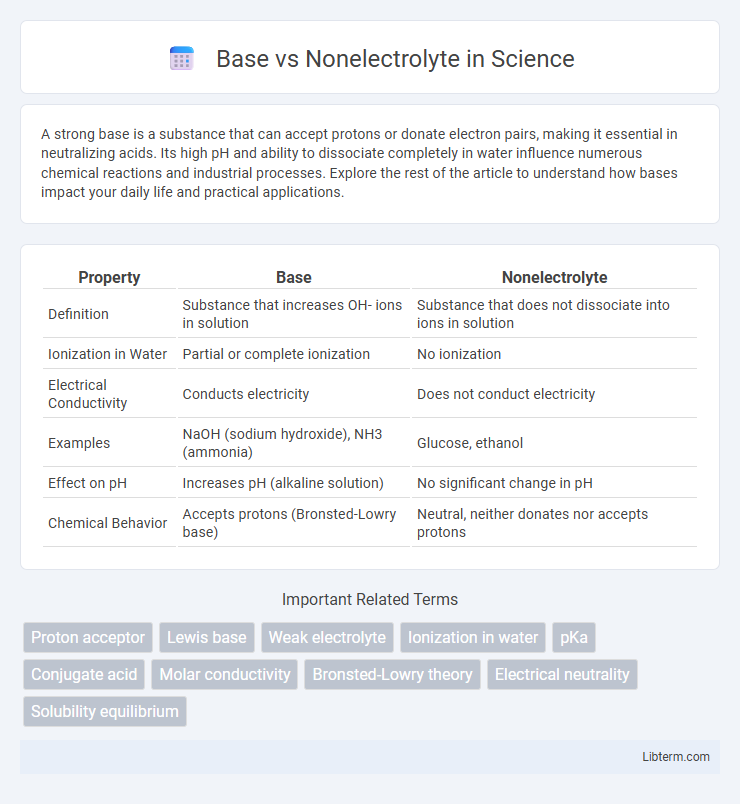A strong base is a substance that can accept protons or donate electron pairs, making it essential in neutralizing acids. Its high pH and ability to dissociate completely in water influence numerous chemical reactions and industrial processes. Explore the rest of the article to understand how bases impact your daily life and practical applications.
Table of Comparison
| Property | Base | Nonelectrolyte |
|---|---|---|
| Definition | Substance that increases OH- ions in solution | Substance that does not dissociate into ions in solution |
| Ionization in Water | Partial or complete ionization | No ionization |
| Electrical Conductivity | Conducts electricity | Does not conduct electricity |
| Examples | NaOH (sodium hydroxide), NH3 (ammonia) | Glucose, ethanol |
| Effect on pH | Increases pH (alkaline solution) | No significant change in pH |
| Chemical Behavior | Accepts protons (Bronsted-Lowry base) | Neutral, neither donates nor accepts protons |
Introduction to Bases and Nonelectrolytes
Bases are substances that increase the concentration of hydroxide ions (OH-) in an aqueous solution, typically characterized by a bitter taste and slippery feel; common examples include sodium hydroxide and ammonia. Nonelectrolytes are compounds that do not dissociate into ions when dissolved in water, resulting in solutions that do not conduct electricity, such as sugar and ethanol. Understanding the distinction between bases, which affect solution pH and conductivity, and nonelectrolytes, which remain molecular and non-ionized, is fundamental in chemistry for predicting solution behavior.
Defining Base: Properties and Examples
A base is a substance that increases the concentration of hydroxide ions (OH-) in aqueous solution, exhibiting properties such as a bitter taste, slippery texture, and ability to change red litmus paper from red to blue. Common examples include sodium hydroxide (NaOH), potassium hydroxide (KOH), and ammonia (NH3), which act as bases by accepting protons or releasing OH- ions. Bases, as electrolytes, dissociate partially or fully in water, enabling electrical conductivity, unlike nonelectrolytes that do not dissociate into ions.
Nonelectrolyte Explained: Characteristics and Types
Nonelectrolytes are substances that do not dissociate into ions in aqueous solutions, resulting in no electrical conductivity. Common characteristics include molecular compounds like sugar and ethanol, which dissolve but remain intact as neutral molecules. Types of nonelectrolytes primarily include organic compounds such as alcohols, sugars, and urea, distinguished from bases that ionize and produce hydroxide ions in water.
Chemical Structure Differences: Bases vs Nonelectrolytes
Bases contain hydroxide ions (OH-) or amine groups (NH2) which allow them to dissociate in water and conduct electricity, while nonelectrolytes lack these ionizable groups and do not dissociate into ions in solution. The chemical structure of bases typically includes polar functional groups that can release or accept protons, enabling ionic conduction. In contrast, nonelectrolytes consist of covalent molecules with stable bonds that don't ionize, resulting in no electrical conductivity.
Ionization in Water: Base vs Nonelectrolyte Behavior
Bases ionize in water by dissociating into hydroxide ions (OH-) and corresponding cations, increasing the solution's conductivity and alkalinity. Nonelectrolytes do not ionize in water, producing no ions and thus contributing no electrical conductivity. The degree of ionization distinguishes bases, which are strong or weak electrolytes, from nonelectrolytes, which remain molecular and non-conductive in aqueous solutions.
Conductivity Comparison: Base Versus Nonelectrolyte Solutions
Base solutions contain hydroxide ions (OH-) that dissociate in water, significantly increasing the solution's conductivity. Nonelectrolyte solutions, such as sugar or ethanol in water, do not dissociate into ions and therefore exhibit very low or negligible electrical conductivity. Conductivity measurements show that base solutions conduct electricity much more effectively than nonelectrolyte solutions due to the presence of mobile charged particles.
pH Levels: Distinguishing Bases and Nonelectrolytes
Bases increase the pH level of a solution by releasing hydroxide ions (OH-), typically resulting in pH values above 7, indicating alkalinity. Nonelectrolytes do not dissociate into ions in solution and therefore have no significant effect on pH, maintaining a neutral pH around 7. Measuring pH levels effectively distinguishes bases, which raise pH, from nonelectrolytes, which do not alter it.
Real-world Examples: Uses of Bases and Nonelectrolytes
Bases like sodium hydroxide (NaOH) and ammonia (NH3) are widely used in industries for neutralizing acids, manufacturing soaps, and as cleaning agents due to their hydroxide ion dissociation in water, making them strong electrolytes. Nonelectrolytes such as glucose and ethanol do not dissociate into ions, making them essential in pharmaceuticals and food industries where electrical conductivity is undesirable. Their distinct properties dictate their application, with bases vital for chemical reactions requiring ionic conductivity, while nonelectrolytes serve as solvents or nutritional additives without altering electrical conductance.
Laboratory Identification Methods
Laboratory identification of bases involves using indicators such as litmus paper, where bases turn red litmus paper blue due to hydroxide ion presence, distinguishing them from nonelectrolytes that do not ionize or conduct electricity in solution. Conductivity tests offer another method, as bases dissociate into ions and exhibit high electrical conductivity, whereas nonelectrolytes remain molecular with minimal to no conductivity. Additionally, pH measurement using a pH meter or universal indicator helps differentiate strong bases (pH > 7) from nonelectrolytes that typically show neutral pH due to lack of ionization.
Summary: Key Distinctions Between Bases and Nonelectrolytes
Bases are substances that increase hydroxide ions (OH-) in aqueous solutions, exhibiting ionic dissociation and high electrical conductivity. Nonelectrolytes, such as sugar or ethanol, do not ionize in water and thus do not conduct electricity. The key distinction lies in the ionization behavior, where bases dissociate into ions while nonelectrolytes remain as neutral molecules, affecting their chemical reactivity and conductivity.
Base Infographic

 libterm.com
libterm.com